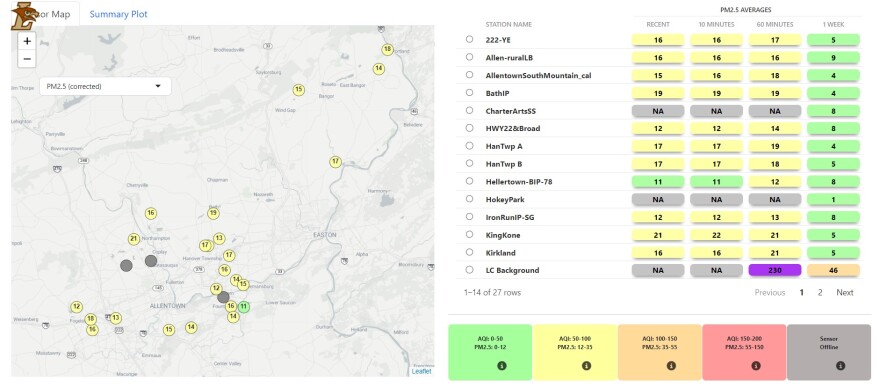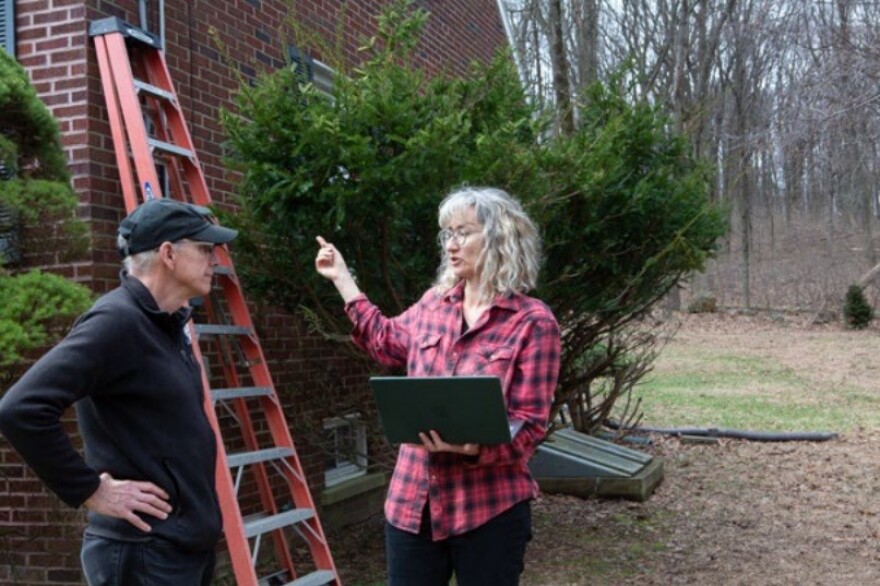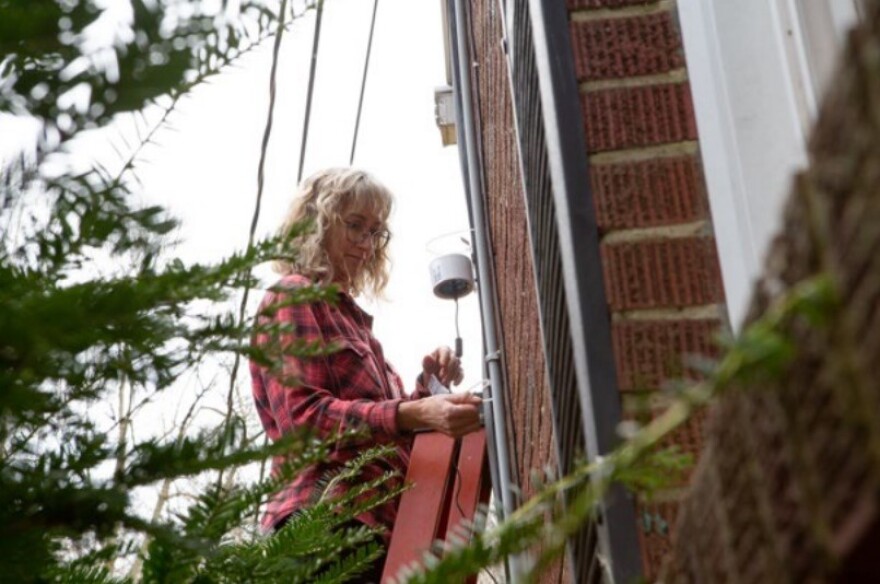BETHLEHEM, Pa. — Installing air quality monitors is not for those with a fear of heights, said officials behind the region’s $100,000 project, Lehigh Valley Breathes.
“We were able to install more monitors in the last month,” according to the March project update, posted online. Included in the update were photos of Technical Manager Breena Holland, who climbed a ladder to place a monitor at a brick home in Salisbury Township.
“We thought you might like to see what’s involved in a monitor installation,” the update said.
More than six months after its launch, 33 air quality monitors have been installed throughout the Valley as part of the air monitoring project, a regionwide effort to monitor air quality amid emissions from trucking and warehousing. As part of the effort, 40 PurpleAir monitors are slated to be installed.
While almost three dozen monitors are in place so far, only 27 appear on the Shiny App, the project’s online dashboard.

“That’s a function of some using SD cards, as we’ve explained before, and some having unexpected reporting problems,” officials said. “One monitor developed a non-functional laser (there are two lasers in each monitor). Another one cannot connect to a hotspot.
“We are working on several to check out their difficulties and fix the issues.”
Preliminary data
So far, preliminary data collected through the project has shown fine particle pollution is highest near warehouses and highways.
The highest concentrations of PM 2.5 were recorded in places that are proximate to both warehouses and highways, officials said. However, a monitor sited in a rural area with high truck traffic measured higher than an urban corridor area near warehouses.
PM 2.5 are particles so small that they’re invisible to the naked eye, but are made up of a mix of chemicals that can get deep into the lungs and can cause health problems. They are measured in micrograms per cubic meter, or µg/m3.
Concentrations at monitoring sites near warehouses and highways have recorded 9.7 and 7.8 µg/m3, respectively, data shows.
The World Health Organization recommends the annual average concentration of PM 2.5 should not exceed 5 µg/m3.

‘Citizen science’
Officials in the March update emphasized how the project was designed to engage residents through citizen science, with “opportunities for average citizens to participate in the project, contributing information and learning more about the science involved.”
“The first step was to call for residents to volunteer locations for the monitors,” officials said in the update. “We were delighted to have an enthusiastic response to that request in August and have continued to receive offers of locations ever since then as more people learn about the project. That’s helpful as we fine-tune the final locations of the monitors."
Another facet of the citizen science component is collecting feedback from residents who host monitors, officials said, detailing the experiences of a woman whose monitor was installed last July at her home in Lehigh County.
While officials didn’t release her name, citing privacy concerns, they described her as a professional who has been working from home since the COVID-19 pandemic began and enjoys walking for exercise. However, she also deals with moderate to severe asthma.
“In the past, she had tried to use the air quality numbers from the Weather Channel to help her make an informed decision, but she found it frustrating,” officials said. “The numbers were not well correlated to where she lives, so some days, they would indicate good air, yet it would be hard to breathe.
“On other days, she’d stay inside based on the readings and later discover it was breathable outside. She had tried wearing a mask while walking, but that didn’t solve the problem.”
She volunteered to host for Lehigh Valley Breathes, and her home was just what researchers were looking for — an urban corridor, non-proximate to a highway with low traffic in a residential area.
“We installed her monitor in mid-July 2023, just towards the end of the time when our air quality was seriously affected by the Canadian wildfires,” officials said. “She found the monitor immediately useful during that difficult period, especially as the visible smokiness dissipated, but the air quality still did not move back into the healthy zone.”
Since then, she’s continued to use the monitor readings when she wants to walk outdoors. However, she noted she was surprised by how variable the readings have been.
“She expected that once we were back to ‘normal,’ and since she didn’t live near a highway, the readings would be more stable,” officials said. “However, looking at the readings just from the past week, we can see that although the readings hovered around 10 µg/m3 through most of the week, there were two days with spikes of 31.6 and 47.6, respectively, which would be problematic for members of sensitive groups, as she is.”
“It’s been good to have it. It’s been very helpful. I’m looking forward to seeing what the results of the entire project are."Lehigh County Breathes monitor host
“It’s been good to have it. It’s been very helpful,” the woman told officials when asked how she felt about the monitor and the project. “I’m looking forward to seeing what the results of the entire project are.
“I’m very comfortable with having it here for a year. It’s caused no disruption.”
Officials encouraged monitor hosts who would like to share their experiences to email lvbreathes@gmail.com.
“This summer, we hope to send a survey to all of our monitor hosts asking for feedback on the project and also if they might consider closely checking and reporting the data for a short period of time as well as any unusual readings or observations they’ve had since their monitor was installed,” according to the release. “All of this provides not just objective data but also subjective reactions to produce a well-rounded view of the air that we all have to breathe.
“Until next month, breathe easy.”
For more information, visit the Lehigh County or Northampton County website for Lehigh Valley Breathes.


